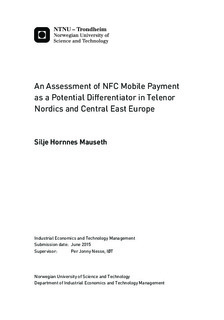| dc.description.abstract | The telecommunication industry is changing rapidly and the entrance of new firms increases the competition. To survive in the rapidly changing environment, MNOs need to pursue innovative services to create growth, value and to differentiate from competitors.
Telenor, one of the world s major mobile operators, has chosen financial services to be a part of their innovation. Mobile financial services can serve different functions in emerging and mature markets, banking the unbanked and convenient electronic transactions respectively. Near Field Communication (NFC) technology plays an important role in the latter function and offers Telenor a range of opportunities related to mobile wallets. NFC is a short-range, bi-directional, wireless communication technology based on Radio Frequency Identification (RFID) technology. Three devices can be involved in NFC communication: NFC mobile devices, NFC readers and NFC tags.
However, the technology itself is seldom enough to create a successful service. This master thesis examines the various success factors of NFC mobile payment services by assessing a selection of such services, both external and internal to Telenor. Strengths and weaknesses are identified regarded NFC in the three Telenor markets Norway, Hungary and Serbia. Recommendations are proposed based on the identified strengths and weaknesses to guide Telenor in their further efforts to successfully using NFC mobile payment as a differentiator.
Selected NFC services and success factors
Four launched NFC mobile payment services are described and assessed according to their degree of success. Cep-T Cüzdan from Turkey and Apple Pay from the US are considered successful, while Google Wallet is considered a failure. The success of MyWallet from Germany is difficult to assess as the service is recently launched. Key success factors presented in the theory section are applied to explain the different degrees of success. Cooperation and partnerships, creating consumer value, the technical solution, available contactless POS terminals, flexibility and timing are among the factors considered to influence the level of success of the four selected services.
Strengths and weaknesses of three Telenor markets NFC activity
A framework is developed to assess the NFC activity of Telenor Norway, Hungary and Serbia. The framework consists of six pillars that all influence the outcome of a NFC initiative. Strengths and weaknesses are identified regarding each of the six pillars. Some of the strengths and weaknesses are common for more of the markets but most of them are country specific. The identified strengths and weaknesses of the six pillars can be categorised according to the topics presented below:
1. Infrastructure
a. Contactless POS terminals
b. NFC ready mobile devices
c. Payment culture
2. Partnerships and cooperation
a. Culture of cooperation
b. Previous experience
c. Ecosystem involvement
3. Technical solution
a. Security
b. Flexibility
c. Infrastructure requirements
4. Implementation
a. Visibility and awareness
b. Marketing efforts and advertising
c. Education of ecosystem actors
5. Timing and competition
a. Timing of launch
b. Domestic and global competition
c. Time window
6. Regulation
a. Local regulation
b. European and global regulation
c. Standardisation
Although the topics are very different, most of them seem to impact the overall objective, consumer adoption. Creating consumer value to achieve consumer adoption is therefore critical and the strengths may be seen to increase this value, while the weaknesses reduce it.
Proposed recommendations for Telenor s NFC activity
The strengths and weaknesses identified regarding each pillar are organised according to different stages. These stages consist of a pre-stage where the market readiness is measured, and the diffusion stages of a mobile payment solution presented by Ondrus et al (2009).
Many recommendations are suggested for each pillar to improve an initiative s chance of success. Some of the key recommendations are presented below:
1. Infrastructure
a. Arrange workshops for key merchants to identify their barriers and benefits to be able to provide an adapted approach.
b. Prioritise value-added services related to loyalty programs and in-store experience to recruit merchants.
c. Ensure that all efforts are adapted to the specific market.
2. Partnerships and cooperation
a. Ensure a win-win business model.
b. Prioritise communication and clearly specifying the responsibilities of the involved ecosystem actors at an early stage.
c. Seek to involve more MNOs in the initiative to increase market reach and publicity.
3. Technical solution
a. Seek flexibility.
4. Implementation
a. Prioritise marketing and education of merchants and consumers.
b. Remove adoption barriers as SIM issuance.
5. Timing and cooperation
a. Develop a decision-supporting tool to assess market readiness.
b. Seek a unique position for your NFC service.
6. Regulation
a. Be proactive by monitoring regulators.
b. Conduct lobbying to influence regulators.
c. Follow industry standards.
The different recommendations are primarily relevant for different diffusion stages.
Hence, by identifying what stages are most critical in their individual case, Telenor can prioritise performing the recommendations influencing these specific stages. | en |

